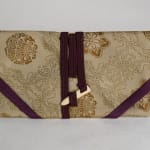











artisan's name unknown
Wrapping Case to Present Money, Taisho Era (1912-1926)
Woven Silk
3 1/2" x 6 3/4" (closed);
11" x 11" (open)
11" x 11" (open)
Further images
-
(View a larger image of thumbnail 1
)

-
(View a larger image of thumbnail 2
)

-
(View a larger image of thumbnail 3
)

-
(View a larger image of thumbnail 4
)

-
(View a larger image of thumbnail 5
)

-
(View a larger image of thumbnail 6
)

-
(View a larger image of thumbnail 7
)

-
(View a larger image of thumbnail 8
)

-
(View a larger image of thumbnail 9
)

-
(View a larger image of thumbnail 10
)

-
(View a larger image of thumbnail 11
)

-
(View a larger image of thumbnail 12
)

There are situations in which money changes hands in person as a gift, a payment, or a way to express gratitude. Japanese culture has strict protocols for such situations. For...
There are situations in which money changes hands in person as a gift, a payment, or a way to express gratitude. Japanese culture has strict protocols for such situations. For one, money is never presented without being enclosed in an envelope or some form of wrapping.
This woven silk case was made for this specific protocol. Bills are placed in a proper envelope of a certain size. The envelope slides into the case and it is tied shut so it can be carried inside one’s bag. When presenting the envelope, the case is unfolded and the envelope is taken out from its compartment, then handed to the recipient.
Although this case was made for a single purpose, only used every so often, it is made with the highest level of artistry. Over a century old, it is no longer bound by strict protocols and can be used for other occasions. These days a proper paper envelope is sufficient. It is such a joy to imagine how to use this case today.
This woven silk case was made for this specific protocol. Bills are placed in a proper envelope of a certain size. The envelope slides into the case and it is tied shut so it can be carried inside one’s bag. When presenting the envelope, the case is unfolded and the envelope is taken out from its compartment, then handed to the recipient.
Although this case was made for a single purpose, only used every so often, it is made with the highest level of artistry. Over a century old, it is no longer bound by strict protocols and can be used for other occasions. These days a proper paper envelope is sufficient. It is such a joy to imagine how to use this case today.
Signup for our Newsletter
You will receive two emails a month from us. One introduces artworks and design works from Kyoto's hidden sources and the other is stories from Misako, sharing insights into Japanese culture.
* denotes required fields
为了回应您的查询,我们将根据我们的隐私政策处理您提供的个人数据。